Doubling the Carbonate-Binding Capacity of Nanojars by the Formation of Expanded Nanojars
Abstract
:1. Introduction
2. Results and Discussion
2.1. Crystallographic Description
2.2. Mass Spectrometric Studies
3. Materials and Methods
3.1. Mass Spectrometry
3.2. X-ray Crystallography
4. Conclusions
Author Contributions
Funding
Institutional Review Board Statement
Informed Consent Statement
Data Availability Statement
Acknowledgments
Conflicts of Interest
Sample Availability
References
- Ahmed, B.M.; Szymczyna, B.R.; Jianrattanasawat, S.; Surmann, S.A.; Mezei, G. Survival of the Fittest Nanojar: Stepwise Breakdown of Polydisperse Cu27–Cu31 Nanojar Mixtures into Monodisperse Cu27(CO3) and Cu31(SO4) Nanojars. Chem. Eur. J. 2016, 22, 5499–5503. [Google Scholar] [CrossRef]
- Fernando, I.R.; Surmann, S.A.; Urech, A.A.; Poulsen, A.M.; Mezei, G. Selective total encapsulation of the sulfate anion by neutral nano-jars. Chem. Commun. 2012, 48, 6860–6862. [Google Scholar] [CrossRef] [PubMed]
- Mezei, G. Incarceration of one or two phosphate or arsenate species within nanojars, capped nanojars and nanohelicages: Helical chirality from two closely-spaced, head-to-head PO43− or AsO43− ions. Chem. Commun. 2015, 51, 10341–10344. [Google Scholar] [CrossRef] [PubMed]
- Mezei, G.; Baran, P.; Raptis, R.G. Anion Encapsulation by Neutral Supramolecular Assemblies of Cyclic CuII Complexes: A Series of Five Polymerization Isomers, [{cis-CuII(μ-OH)(μ-pz)}n], n = 6, 8, 9, 12, and 14. Angew. Chem. Int. Ed. 2004, 43, 574–577. [Google Scholar] [CrossRef] [PubMed]
- Hen, L.; Berry, S.N.; Wu, X.; Howe, E.N.W.; Gale, P.A. Advances in Anion Receptor Chemistry. Chem 2020, 6, 61–141. [Google Scholar]
- Liu, Y.; Sengupta, A.; Raghavachari, K.; Flood, A.H. Anion Binding in Solution: Beyond the Electrostatic Regime. Chem 2017, 3, 411–427. [Google Scholar] [CrossRef] [Green Version]
- Molina, P.; Zapata, F.; Caballero, A. Anion Recognition Strategies Based on Combined Noncovalent Interactions. Chem. Rev. 2017, 117, 9907–9972. [Google Scholar] [CrossRef]
- Busschaert, N.; Caltagirone, C.; Van Rossom, W.; Gale, P.A. Applications of Supramolecular Anion Recognition. Chem. Rev. 2015, 115, 8038–8155. [Google Scholar] [CrossRef]
- Jacobson, B.L.; Quiocho, F.A. Sulfate-Binding Protein Dislikes Protonated Oxyacids: A Molecular Explanation. J. Mol. Biol. 1988, 204, 783–787. [Google Scholar] [CrossRef]
- Gonzalez, D.; Richez, M.; Bergonzi, C.; Chabriere, E.; Elias, M. Crystal structure of the phosphate-binding protein (PBP-1) of an ABC-type phosphate transporter from Clostridium perfringens. Sci. Rep. 2014, 4, 6636. [Google Scholar] [CrossRef]
- Ahmed, B.M.; Calco, B.; Mezei, G. Tuning the structure and solubility of nanojars by peripheral ligand substitution, leading to unprecedented liquid–liquid extraction of the carbonate ion from water into aliphatic solvents. Dalton Trans. 2016, 45, 8327–8339. [Google Scholar] [CrossRef] [PubMed]
- Mezei, G. Selective Extraction of Anions from Solutions. U.S. Patent 10,087,197 B2, 2 October 2018. U.S. Patent 9,901,901 B2, 27 February 2018; European Patent 2852558 B1, 9 September 2020. [Google Scholar]
- Haiduc, I. Inverse coordination—An emerging new chemical concept. Oxygen and other calchogens as coordination centers. Coord. Chem. Rev. 2017, 338, 1–26. [Google Scholar] [CrossRef]
- Haiduc, I. Inverse coordination—An emerging new chemical concept. II. Halogens as coordination centers. Coord. Chem. Rev. 2017, 348, 71–91. [Google Scholar] [CrossRef]
- Haiduc, I. Nitrogen centered inverse coordination complexes. A survey of molecular topologies. J. Coord. Chem. 2018, 71, 3139–3179. [Google Scholar] [CrossRef]
- Haiduc, I. Review. Inverse coordination. Inorganic open and cyclic nitrogen heteroatom molecules as coordination centers. A survey of molecular topologies. J. Coord. Chem. 2019, 72, 35–52. [Google Scholar] [CrossRef]
- Haiduc, I. Review. Inverse coordination. Organic nitrogen heterocycles as coordination centers. A survey of molecular topologies and systematization. Part 1. Five-membered and smaller rings. J. Coord. Chem. 2019, 72, 2127–2159. [Google Scholar] [CrossRef]
- Haiduc, I. Review. Inverse coordination. Organic nitrogen heterocycles as coordination centers. A survey of molecular topologies and systematization. Part 2. Six-membered rings. J. Coord. Chem. 2019, 72, 2805–2903. [Google Scholar] [CrossRef]
- Haiduc, I. Inverse coordination metal complexes with oxalate and sulfur, selenium and nitrogen analogues as coordinationcenters. Topology and systematization. J. Coord. Chem. 2020, 73, 1619–1700. [Google Scholar] [CrossRef]
- Haiduc, I.; Tiekink, E.R.T. Inverse Coordination. A Novel Chemical Concept; Sunway University Press: Sunway City, Selangor, Malaysia, 2020. [Google Scholar]
- Velasco, V.; Aguilà, D.; Barrios, L.A.; Borilovic, I.; Roubeau, O.; Ribas-Ariño, J.; Fumanal, M.; Teat, S.J.; Aromí, G. New coordination features; a bridging pyridine and the forced shortest non-covalent distance between two CO32− species. Chem. Sci. 2015, 6, 123–131. [Google Scholar] [CrossRef] [Green Version]
- Einstein, F.W.B.; Willis, A.C. Crystal and molecular structure of μ-carbonato-di-μ-chloro-tetrakis(bis(3-aminopropyl)amine)tetracopper(II) chloride hydrate. Inorg. Chem. 1981, 20, 609–614. [Google Scholar] [CrossRef]
- Escuer, A.; Peñalba, E.; Vicente, R.; Solans, X.; Font-Bardía, M. Two new tetranuclear µ4-carbonato copper(II) complexes. Syntheses, crystal structure and magnetic behaviour of [(µ4-CO3)(µ-Br)2{Cu4(bapa)4}]Br4 and [(µ4-CO3)(µ-Cl)2{Cu4(bapma)4}]Cl4·12H2O [bapa = bis(aminopropyl)amine and bapma = bis(aminopropyl)methylamine]. J. Chem. Soc. Dalton Trans. 1997, 2315–2320. [Google Scholar] [CrossRef]
- Rodríguez, M.; Llobet, A.; Corbella, M.; Müller, P.; Usón, M.A.; Martelle, A.E.; Reibenspiese, J. Solvent controlled nuclearity in Cu(II) complexes linked by the CO32− ligand: Synthesis, structure and magnetic properties. J. Chem. Soc. Dalton Trans. 2002, 2900–2906. [Google Scholar] [CrossRef]
- Fondo, M.; García-Deibe, A.M.; Corbella, M.; Ruiz, E.; Tercero, J.; Sanmartín, J.; Bermejo, M.R. Unexpected Ferromagnetic Interaction in a New Tetranuclear Copper(II) Complex: Synthesis, Crystal Structure, Magnetic Properties, and Theoretical Studies. Inorg. Chem. 2005, 44, 5011–5020. [Google Scholar] [CrossRef] [PubMed]
- Zhou, H.; Chen, L.; Chen, R.; Peng, Z.-H.; Song, Y.; Pan, Z.-Q.; Huang, Q.-M.; Hua, X.-L.; Bai, Z.-W. Hexamine copper(II) coordination polymers: Synthesis, structure and magnetic properties. CrystEngComm 2009, 11, 671–679. [Google Scholar] [CrossRef]
- Ho, Y.-H.; Chang, M.-C.; Yu, K.-H.; Liu, Y.-H.; Wang, Y.; Cheng, Y.-C.; Chen, J.-T. CO2 fixation by dicopper(II) complexes in hypodentate framework of N8O2. Dalton Trans. 2014, 43, 6287–6290. [Google Scholar] [CrossRef] [PubMed]
- Zhang, X.; Nishihara, S.; Nakano, Y.; Maryunina, K.Y.; Inoue, K. A Cuprate Spin Ladder Linked by a Pyridyl Ligand. Chem. Lett. 2014, 43, 1713–1715. [Google Scholar] [CrossRef] [Green Version]
- Uraev, A.I.; Popov, L.D.; Levchenkov, S.I.; Shcherbakov, I.N.; Suponitsky, K.Y.; Garnovskii, D.A.; Lukov, V.V.; Kogan, V.A. Crystal structure and magnetic properties of a tetranuclear carbonate-bridged CuII complex with a Schiff base compartmental ligand with the N2OS2 donor set. Mendeleev Commun. 2015, 25, 62–64. [Google Scholar] [CrossRef]
- APEX2 v2014.9-0; Bruker AXS Inc.: Madison, WI, USA, 2014.
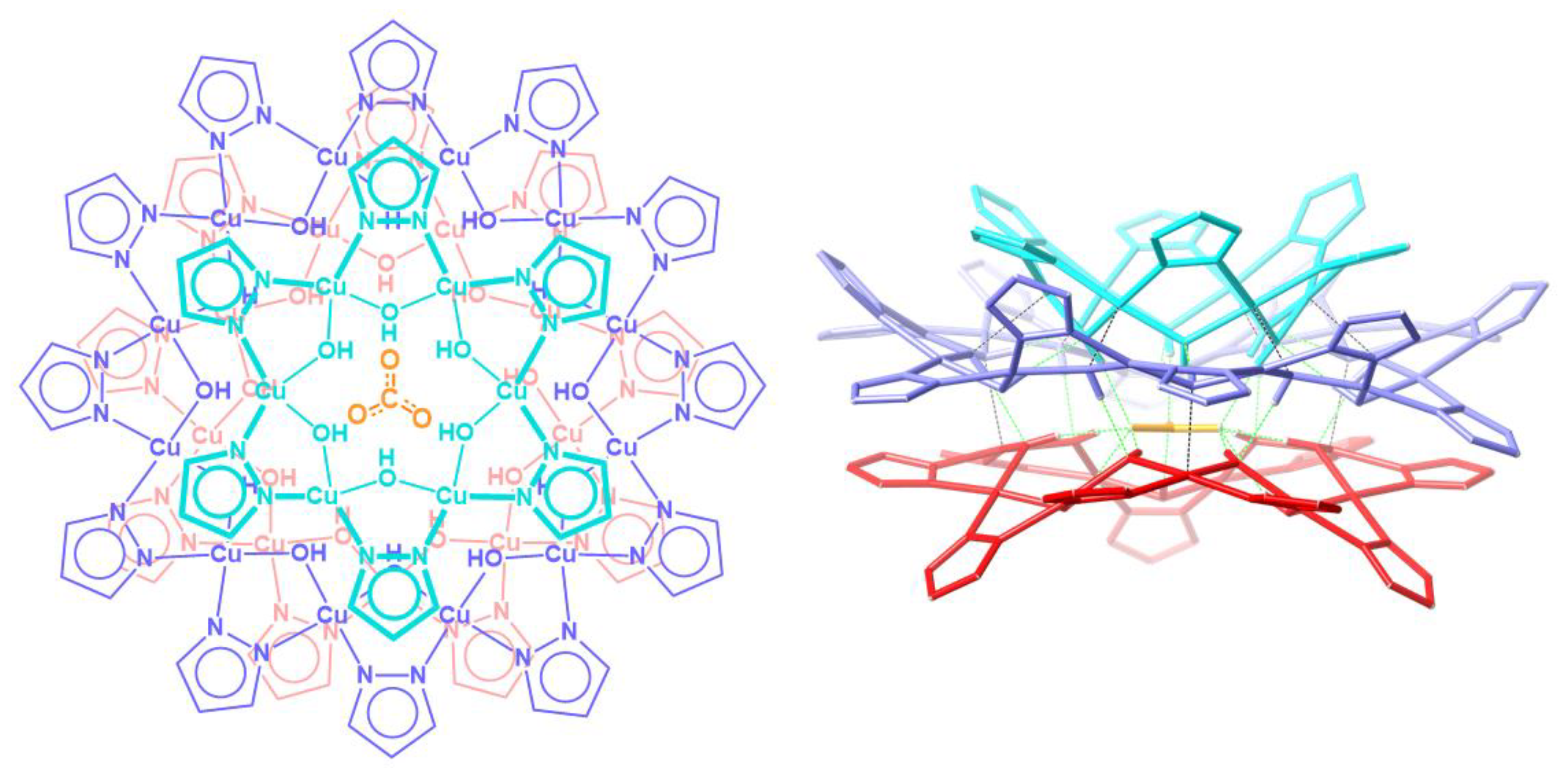
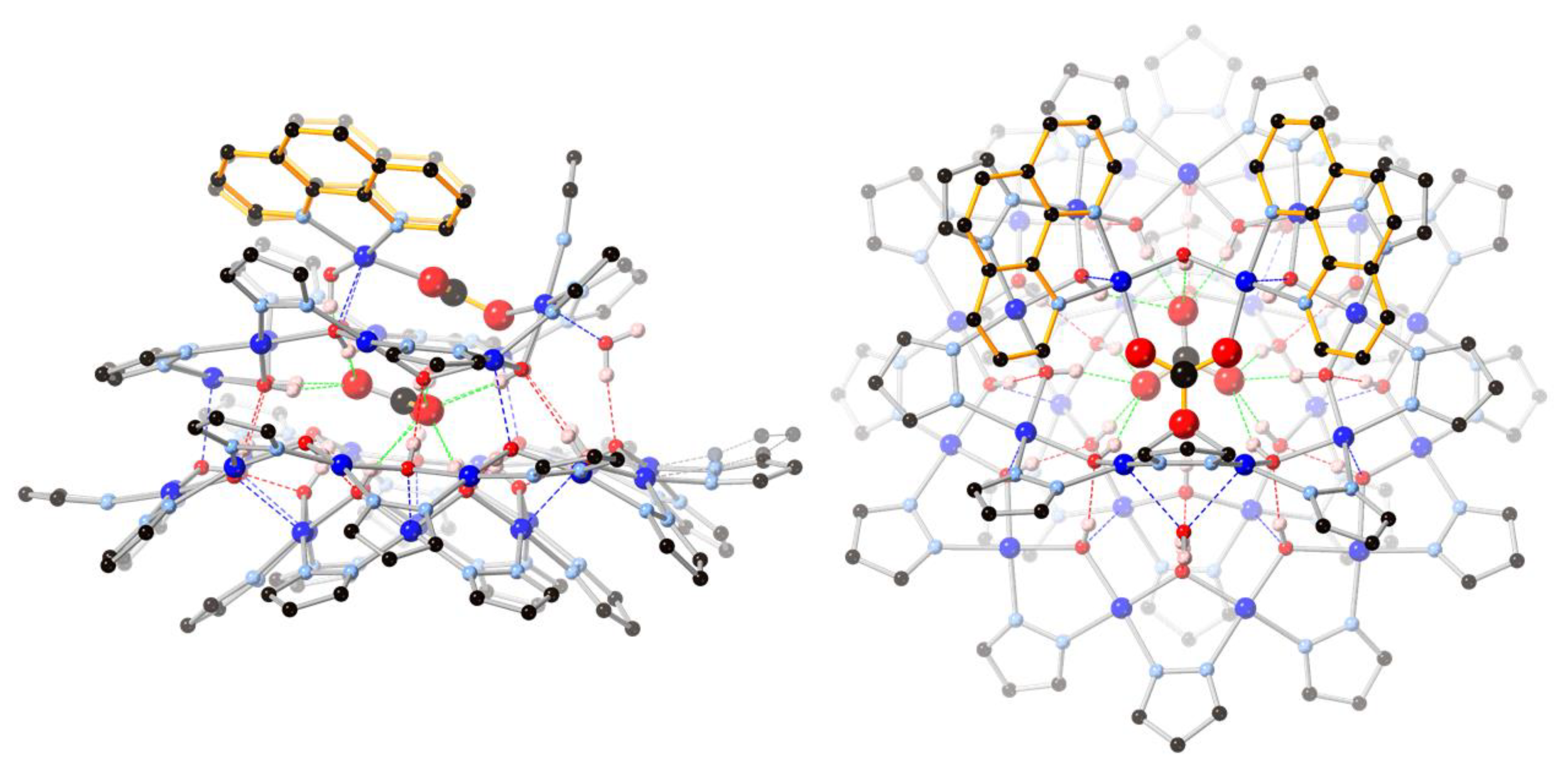
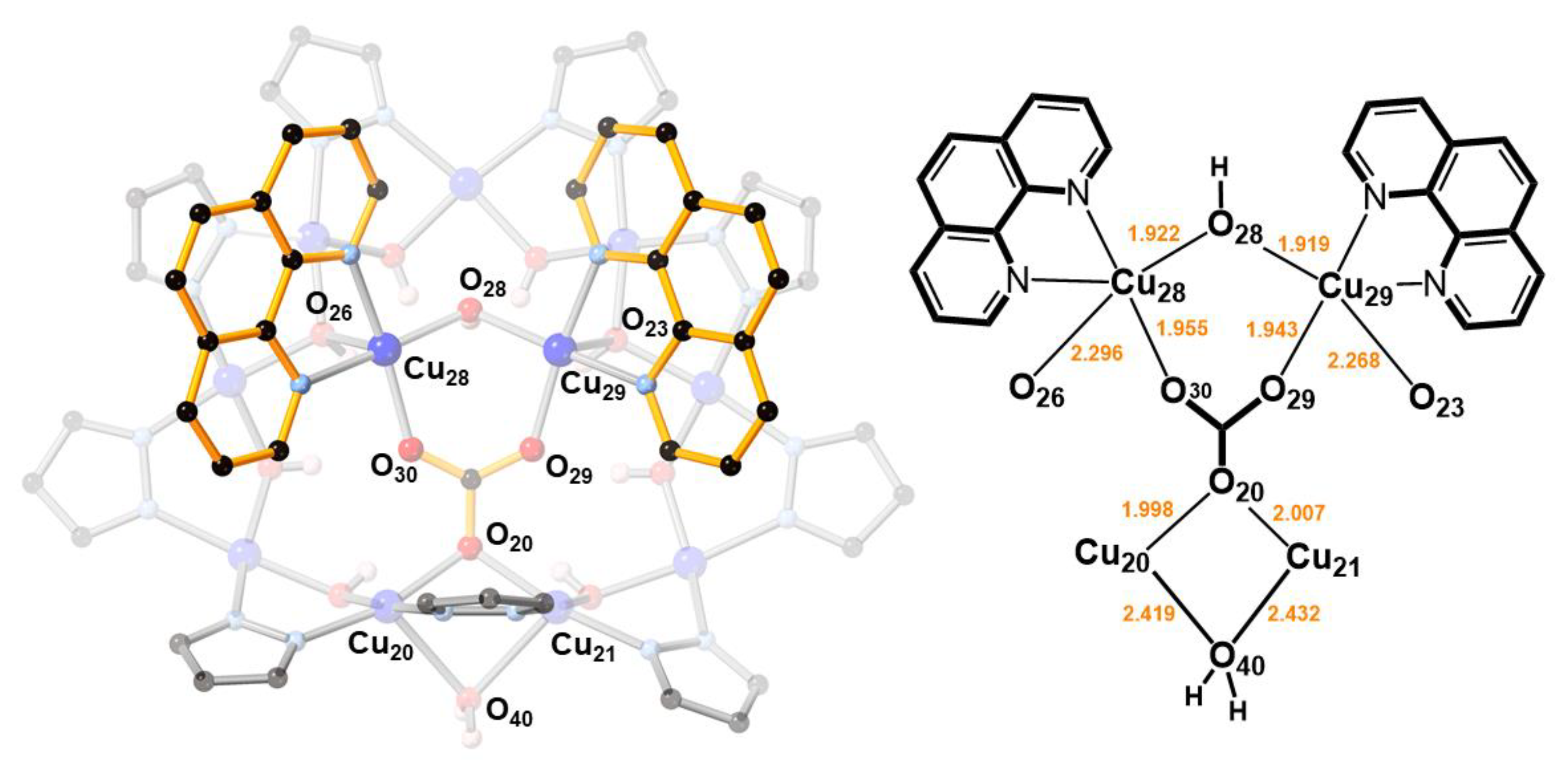
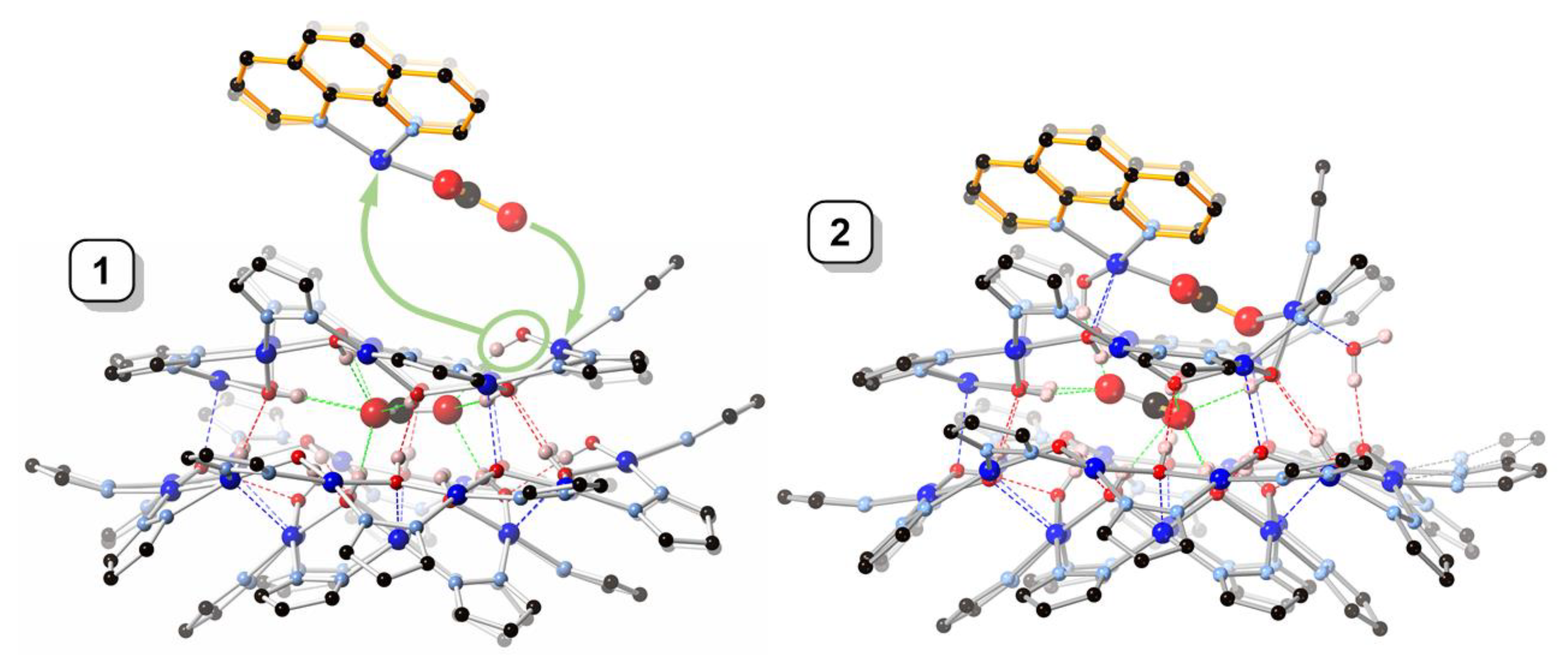


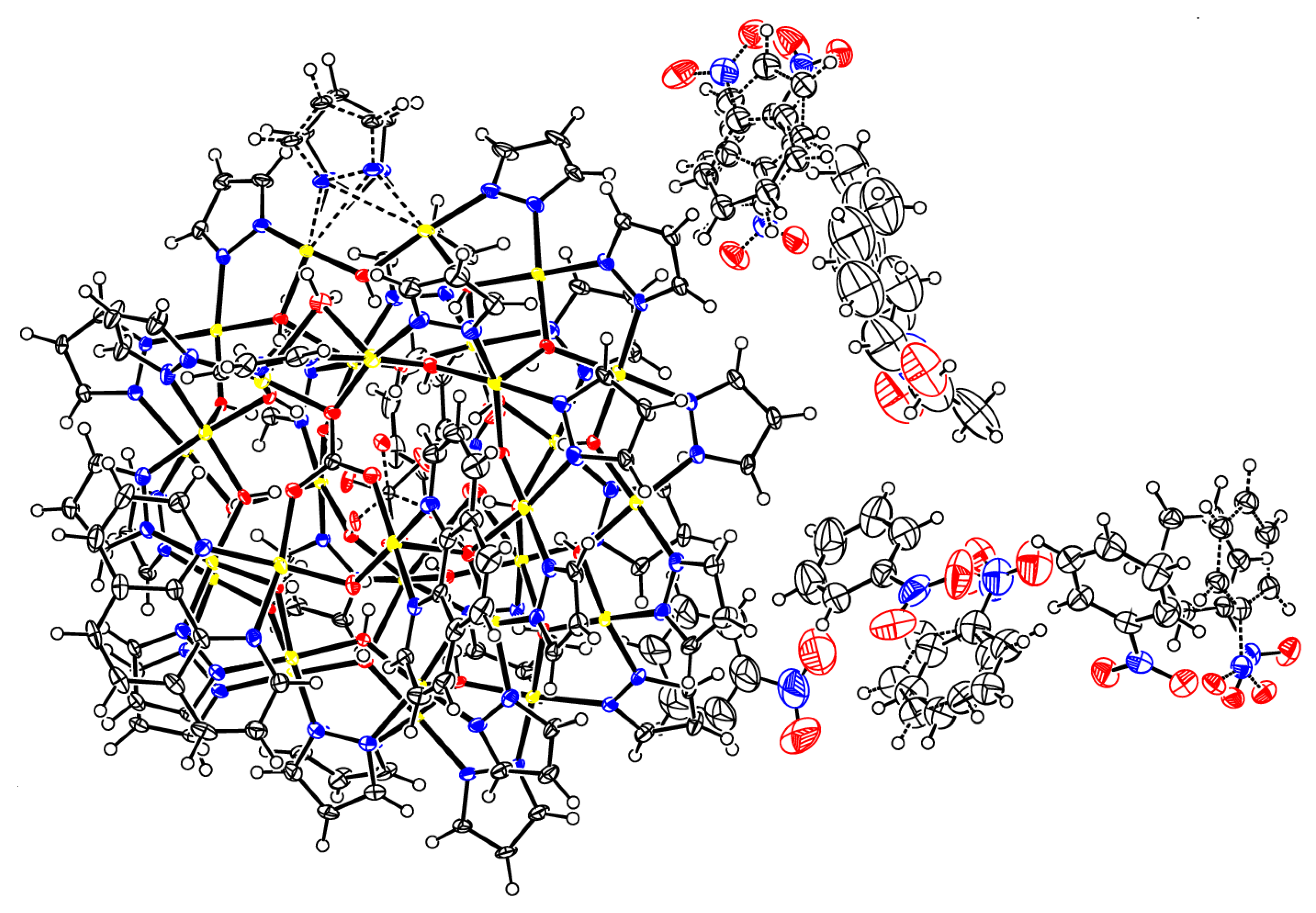
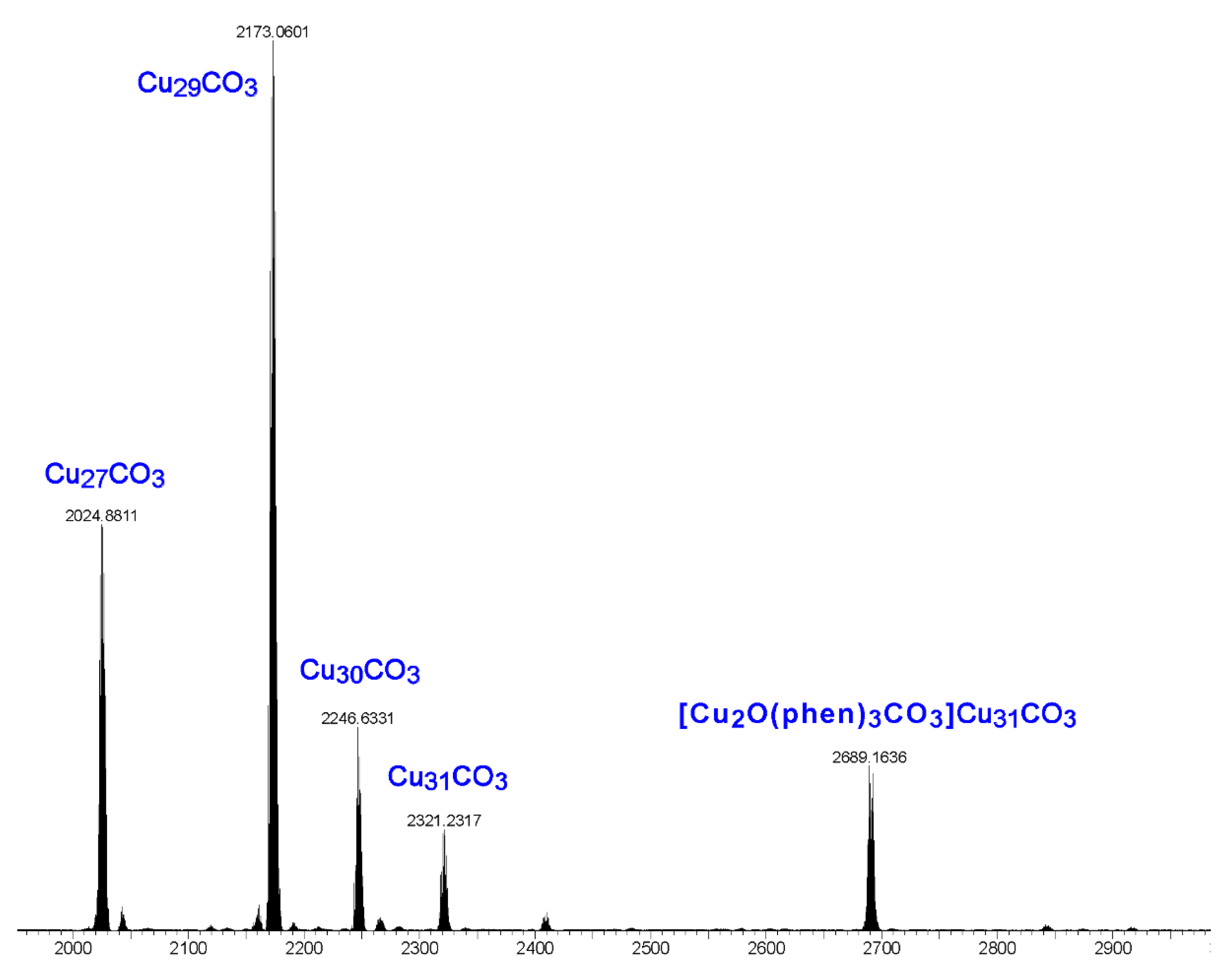
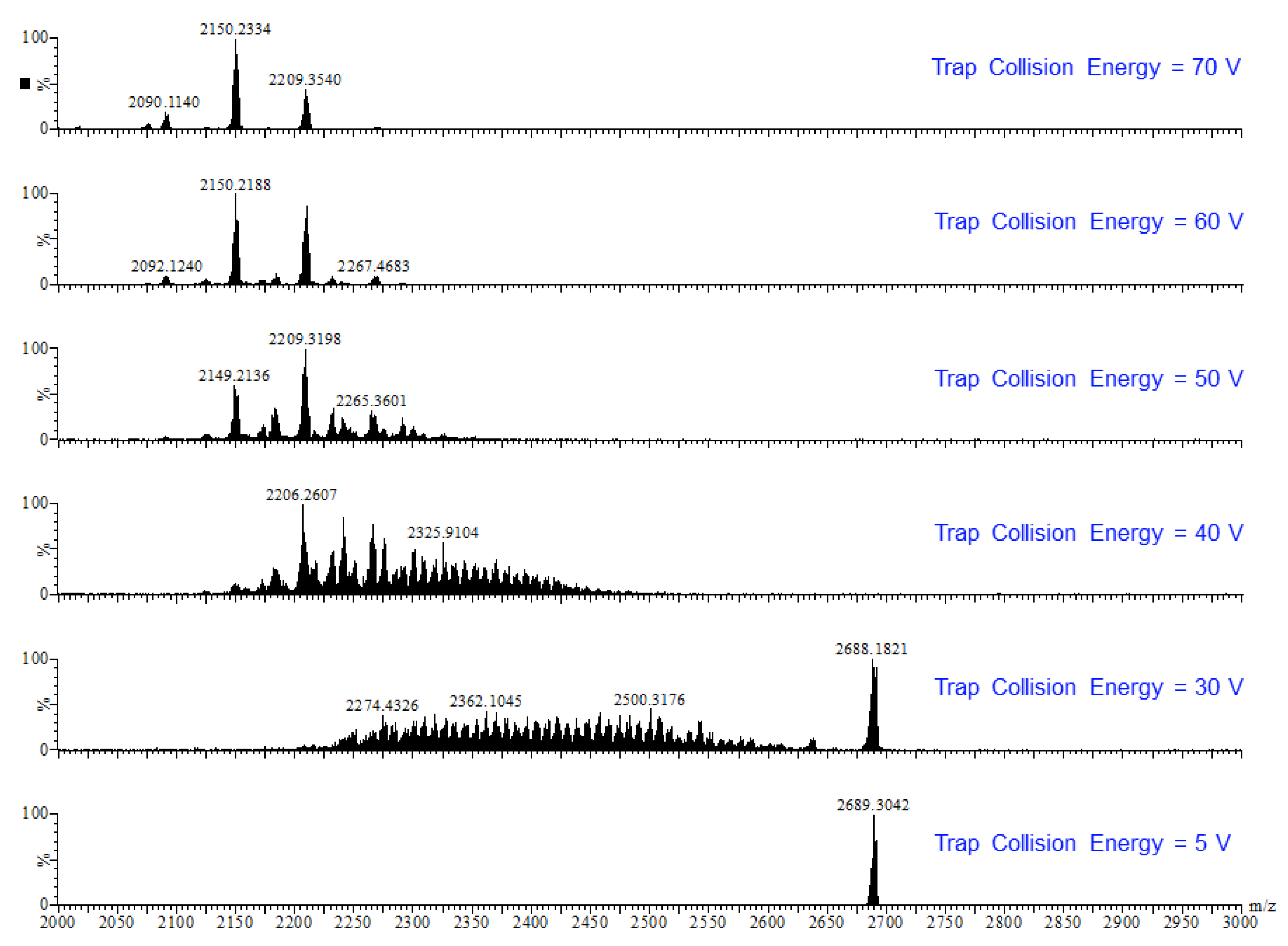

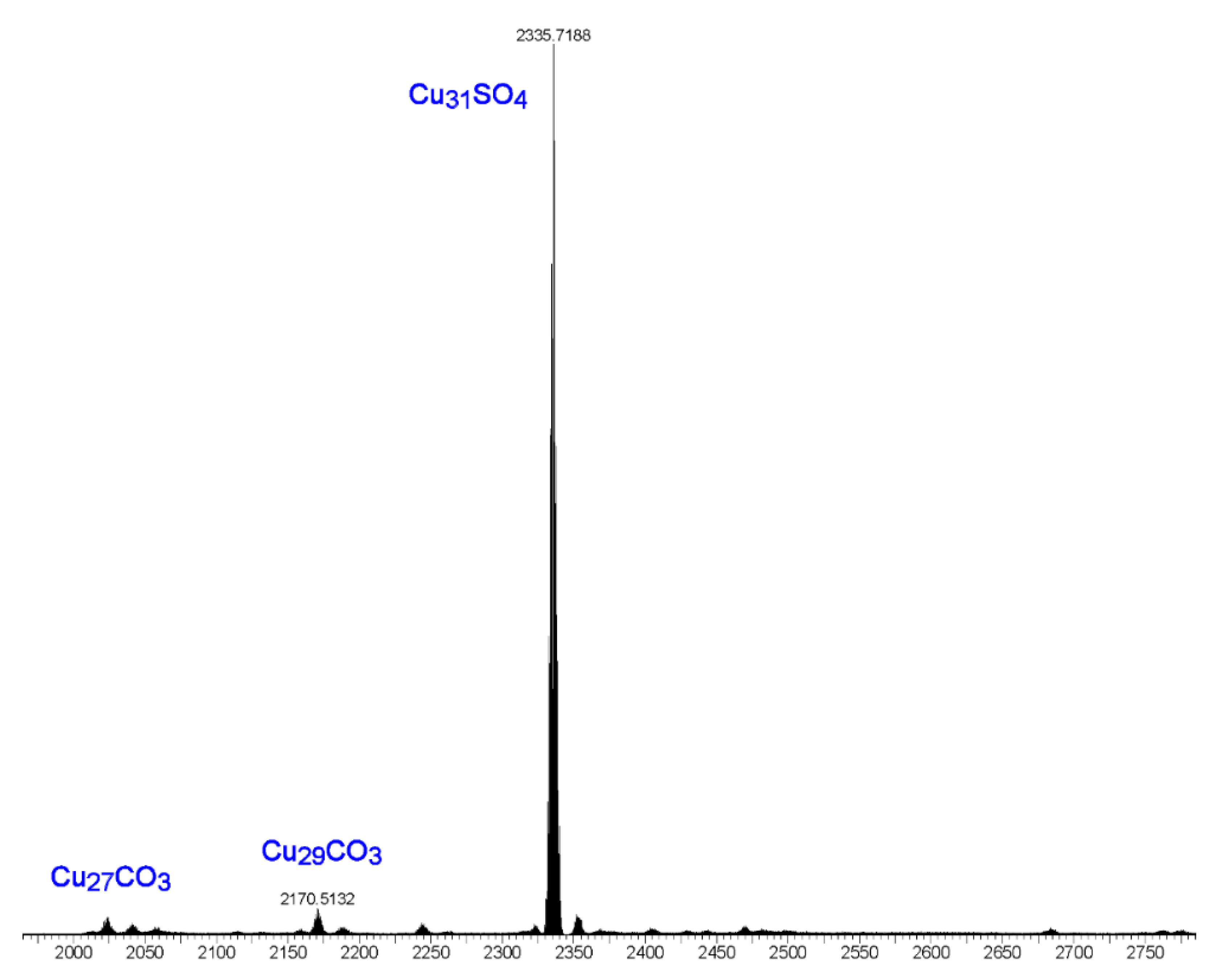
| Cu1–O1 1.906(3) | Cu8–N14 1.964(4) | Cu16–O16 1.928(3) | Cu23–N45 1.946(3) |
| Cu1–O6 1.957(3) | Cu8–N815 2.06(2) | Cu16–N31 1.964(3) | Cu23–O23 1.951(3) |
| Cu1–N12 1.983(4) | Cu9–O9 1.910(3) | Cu16–N30 1.975(4) | Cu23–N44 1.963(3) |
| Cu1–N1 2.025(3) | Cu9–O8 1.935(3) | Cu17–O17 1.908(3) | Cu24–O24 1.891(3) |
| Cu2–O1 1.928(3) | Cu9–N16 1.961(6) | Cu17–O16 1.934(3) | Cu24–N46 1.948(3) |
| Cu2–O2 1.939(3) | Cu9–N17 1.962(3) | Cu17–N32 1.954(4) | Cu24–O23 1.950(3) |
| Cu2–N3 1.982(3) | Cu9–N816 2.00(2) | Cu17–N33 1.974(4) | Cu24–N47 1.968(4) |
| Cu2–N2 2.000(3) | Cu10–O10 1.909(3) | Cu18–O17 1.925(3) | Cu25–O24 1.930(3) |
| Cu2–O11 2.411(3) | Cu10–O9 1.939(3) | Cu18–O18 1.934(3) | Cu25–O25 1.937(3) |
| Cu3–O2 1.928(3) | Cu10–N18 1.961(3) | Cu18–N34 1.963(3) | Cu25–N49 2.001(3) |
| Cu3–O3 1.940(3) | Cu10–N19 1.983(3) | Cu18–N35 1.976(4) | Cu25–N48 2.005(4) |
| Cu3–N4 1.998(3) | Cu11–O11 1.921(3) | Cu19–O27 1.934(3) | Cu25–O14 2.326(3) |
| Cu3–N5 2.003(3) | Cu11–O10 1.931(3) | Cu19–O19 1.958(3) | Cu26–O25 1.893(3) |
| Cu4–O3 1.938(3) | Cu11–N20 1.965(3) | Cu19–N37 1.992(4) | Cu26–N51 1.946(4) |
| Cu4–O4 1.941(3) | Cu11–N21 1.967(3) | Cu19–N54 2.000(3) | Cu26–O26 1.950(3) |
| Cu4–N7 1.981(3) | Cu12–O11 1.924(3) | Cu19–O18 2.399(3) | Cu26–N50 1.975(4) |
| Cu4–N6 2.010(4) | Cu12–O12 1.932(3) | Cu20–O19 1.919(3) | Cu27–O27 1.905(3) |
| Cu5–O5 1.934(3) | Cu12–N23 1.956(4) | Cu20–N38 1.970(4) | Cu27–O26 1.938(3) |
| Cu5–O4 1.941(3) | Cu12–N22 1.966(3) | Cu20–N39 1.989(4) | Cu27–N53 1.961(4) |
| Cu5–N8 1.996(3) | Cu13–O13 1.914(3) | Cu20–O20 1.998(3) | Cu27–N52 1.964(3) |
| Cu5–N9 2.002(4) | Cu13–O12 1.933(3) | Cu20–O40 2.419(3) | Cu28–O28 1.922(3) |
| Cu6–O5 1.916(3) | Cu13–N24 1.953(3) | Cu21–O21 1.911(3) | Cu28–O30 1.954(3) |
| Cu6–O6 1.956(3) | Cu13–N25 1.975(4) | Cu21–N40 1.958(4) | Cu28–N56 2.022(4) |
| Cu6–N11 1.991(3) | Cu14–O14 1.914(3) | Cu21–N41 1.973(4) | Cu28–N55 2.023(4) |
| Cu6–N10 2.006(3) | Cu14–O13 1.926(3) | Cu21–O20 2.007(3) | Cu28–O26 2.296(3) |
| Cu7–O18 1.905(3) | Cu14–N26 1.959(4) | Cu21–O40 2.432(3) | Cu29–O28 1.919(3) |
| Cu7–O7 1.921(3) | Cu14–N27 1.960(3) | Cu22–O22 1.927(3) | Cu29–O29 1.942(3) |
| Cu7–N13 1.954(4) | Cu15–O14 1.923(3) | Cu22–N42 1.969(4) | Cu29–N57 2.019(4) |
| Cu7–N36 1.963(3) | Cu15–O15 1.925(3) | Cu22–O21 1.975(3) | Cu29–N58 2.026(3) |
| Cu8–O7 1.907(3) | Cu15–N29 1.966(3) | Cu22–N43 2.004(4) | Cu29–O23 2.269(3) |
| Cu8–O8 1.941(3) | Cu15–N28 1.969(4) | Cu22–O10 2.318(3) | |
| Cu8–N15 1.943(6) | Cu16–O15 1.916(3) | Cu23–O22 1.894(3) |
| D–H···A | D–H (Å) | H···A (Å) | D···A (Å) | D–H–A (°) |
|---|---|---|---|---|
| O1–H1O···O33 | 0.80(2) | 1.89(2) | 2.687(5) | 170(5) |
| O2–H2O···O33 | 0.78(2) | 2.15(2) | 2.915(5) | 165(5) |
| O2–H2O···O933 | 0.78(2) | 1.91(2) | 2.657(5) | 158(5) |
| O3–H3O···O31 | 0.80(2) | 2.34(2) | 3.124(5) | 166(5) |
| O4–H4O···O32 | 0.80(2) | 2.28(3) | 3.036(5) | 158(5) |
| O4–H4O···O931 | 0.80(2) | 1.92(3) | 2.678(5) | 157(5) |
| O5–H5O···O32 | 0.80(2) | 1.88(2) | 2.677(5) | 175(5) |
| O6–H6O···O932 | 0.80(2) | 1.93(3) | 2.713(5) | 166(5) |
| O7–H7O···O19 | 0.81(2) | 2.11(2) | 2.914(5) | 172(5) |
| O8–H8O···O6 | 0.80(2) | 1.92(2) | 2.716(4) | 178(6) |
| O9–H9O···O21 | 0.81(2) | 2.01(2) | 2.818(4) | 172(5) |
| O10–H10O···O1 | 0.81(2) | 1.93(2) | 2.731(4) | 171(5) |
| O11–H11O···O22 | 0.81(2) | 1.92(2) | 2.731(4) | 175(5) |
| O12–H12O···O2 | 0.80(2) | 2.00(2) | 2.787(4) | 172(5) |
| O13–H13O···O24 | 0.79(2) | 1.95(2) | 2.743(5) | 177(6) |
| O14–H14O···O3 | 0.80(2) | 1.94(2) | 2.721(4) | 168(5) |
| O15–H15O···O25 | 0.81(2) | 1.91(2) | 2.722(4) | 178(5) |
| O16–H16O···O4 | 0.80(2) | 1.96(2) | 2.764(4) | 174(5) |
| O17–H17O···O27 | 0.81(2) | 1.97(2) | 2.767(4) | 171(5) |
| O18–H18O···O5 | 0.80(2) | 1.94(2) | 2.736(4) | 172(5) |
| O19–H19O···O32 | 0.81(2) | 2.17(2) | 2.949(5) | 161(5) |
| O19–H19O···O932 | 0.81(2) | 2.27(3) | 3.055(5) | 166(5) |
| O21–H21O···O33 | 0.80(2) | 2.22(3) | 2.973(5) | 156(5) |
| O21–H21O···O932 | 0.80(2) | 2.30(3) | 3.088(5) | 167(5) |
| O22–H22O···O33 | 0.80(2) | 1.90(2) | 2.696(4) | 170(5) |
| O22–H22O···O933 | 0.80(2) | 2.18(2) | 2.907(4) | 151(5) |
| O23–H23O···O31 | 0.79(2) | 2.47(3) | 3.195(5) | 153(5) |
| O23–H23O···O933 | 0.79(2) | 1.95(3) | 2.730(5) | 167(5) |
| O24–H24O···O31 | 0.80(2) | 1.95(2) | 2.737(5) | 168(5) |
| O24–H24O···O933 | 0.80(2) | 2.29(2) | 3.023(5) | 153(5) |
| O25–H25O···O31 | 0.80(2) | 1.90(3) | 2.682(5) | 164(5) |
| O25–H25O···O931 | 0.80(2) | 2.24(3) | 2.985(5) | 156(5) |
| O26–H26O···O31 | 0.80(2) | 2.33(3) | 3.045(5) | 150(5) |
| O26–H26O···O931 | 0.80(2) | 1.90(3) | 2.693(5) | 177(5) |
| O27–H27O···O32 | 0.80(2) | 1.96(3) | 2.741(5) | 163(5) |
| O27–H27O···O931 | 0.80(2) | 2.14(3) | 2.893(5) | 155(5) |
| O28–H28O···O31 | 0.82(2) | 2.11(3) | 2.895(5) | 159(5) |
| O40–H40O···O8 | 0.82(2) | 1.87(2) | 2.684(5) | 174(6) |
Publisher’s Note: MDPI stays neutral with regard to jurisdictional claims in published maps and institutional affiliations. |
© 2021 by the authors. Licensee MDPI, Basel, Switzerland. This article is an open access article distributed under the terms and conditions of the Creative Commons Attribution (CC BY) license (https://creativecommons.org/licenses/by/4.0/).
Share and Cite
Al Isawi, W.A.; Mezei, G. Doubling the Carbonate-Binding Capacity of Nanojars by the Formation of Expanded Nanojars. Molecules 2021, 26, 3083. https://doi.org/10.3390/molecules26113083
Al Isawi WA, Mezei G. Doubling the Carbonate-Binding Capacity of Nanojars by the Formation of Expanded Nanojars. Molecules. 2021; 26(11):3083. https://doi.org/10.3390/molecules26113083
Chicago/Turabian StyleAl Isawi, Wisam A., and Gellert Mezei. 2021. "Doubling the Carbonate-Binding Capacity of Nanojars by the Formation of Expanded Nanojars" Molecules 26, no. 11: 3083. https://doi.org/10.3390/molecules26113083







